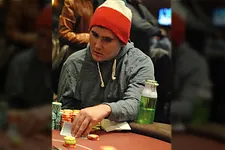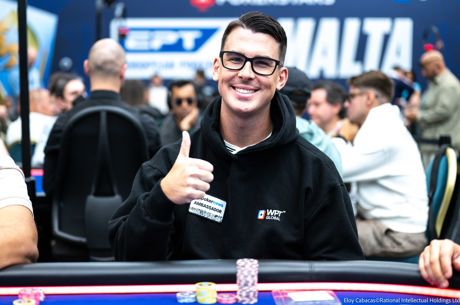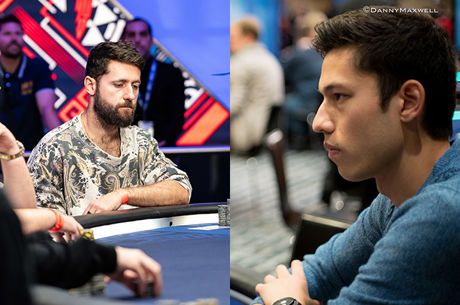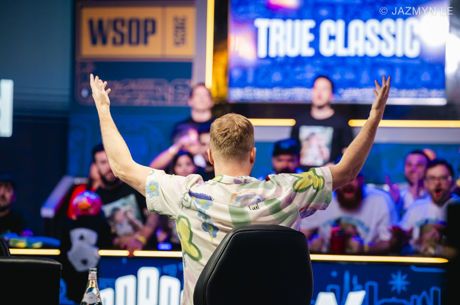Final Table Puzzles, Pt. 1: Thinking in the Face of the Big Shove

Come, walk with me through a final table.
It happened Sunday morning, an ordinary $30 turbo, six-max on PokerStars. The kind you register to fill that extra table slot. I came into the final table with a huge chip lead on account of running unconscionably hot.
Once we were in the money, I shoved Ax7x, got called by QxQx and Ax10x, and scooped. Unconscionably. Hot.
But the deck’s kindness can reverse itself at any time, and once we reached the final table I was made to work for it thereafter. Let’s review that toil, starting with a difficult decision soon after the final table began.
A Raise, Then a Push
Once we lost the sixth-place player, here were the stacks in question:
Hero (UTG): 55 BB
Cutoff (CO): 47 BB
Button (BTN): 20 BB
Small Blind (SB): 19.5 BB
Big Blind (BB): 22 BB
And here were the remaining payouts:
1st: $2,205
2nd: $1,607
3rd: $1,208
4th: $840
5th: $630
On the first hand of five-handed play I am dealt Ax10x-offsuit, min-raise, and face a shove from the BTN. The others step aside. My opponent is a regular, which leads me to believe (among other things) that 10x3x is not in this player’s shoving range.
So I assign the player the following range of possible hands:
- AxKx down to Ax2x-suited)
- AxKx through Ax10x-offsuit)
- pairs from QxQx to 2x2x
- KxQx
- KxJx-suited
Why?
I think our villain would three-bet smaller with some nut set of hands. This range may be wide enough to include 10x10x and higher pairs plus AxKx, but I cannot be sure about that. Many regulars in this situation induce with a wider range than they should in theory.
Giving my opponent credit, or hedging if you like, I took out AxAx and KxKx, but kept those other strong hands.
Removing Flat-Calls
Now the BTN also might have flat-called with some of those hands, such as suited hands like Ax10x, AxJx, KxJx, and Jx10x. To solve this problem as we work out the player’s range, I’d point out two things.
First, if Jx10x-suited flat-calls but isn’t in the shoving range we’re assigning, that does not perturb our calculation.
Next, look back at those stacks in the blinds. This is a very precarious position from which to flat-call. Indeed hands like AxAx or KxKx might be the best flat-calls and nothing else because of the prospect of a three-bet squeeze coming.
My central argument would be that this regular will recognize that some hands that I benefit from having in a shoving range when I hold Ax10x — hands like Ax9x-Ax2x-suited and KxQx-offsuit, for example — will be folding or shoving because flatting is visibly precarious.
A Changing Landscape
So now that we have our opponent’s range, we can plug this situation into ICMizer’s future game simulator which in turn tells us this is essentially a break-even call, dollar-wise.
Of my four opponents, this player is the second best. If I fold I will have a similar stack, more or less, to the CO player on my left. If I call and lose, I’ll be down to 35 BB, and I’ll still have an advantage on the two blinds to my right. If I call and win, I’ll have the clear big stack at the table and the opportunity to wreak havoc. The player on my left will no longer enjoy parity with me.
I think this is close.
We are not going to be making a huge mistake either way, in all likelihood. I think my options are going to largely remain intact when I lose. I don’t have a positional advantage to maintain with a fold, but I can inaugurate a reign of terror if I call and win. I think that clinches it.
I called, my opponent had KxQx-offsuit, and I continued running well above expectation.
In the next part we’ll look at some postflop situations I found myself in as play became short-handed.
Gareth Chantler is a professional poker player who encourages you to check out the interviews, videos, promotions, and strategy articles at the Full Tilt Blog.
Get all the latest PokerNews updates on your social media outlets. Follow us on Twitter and find us on both Facebook and Google+!









